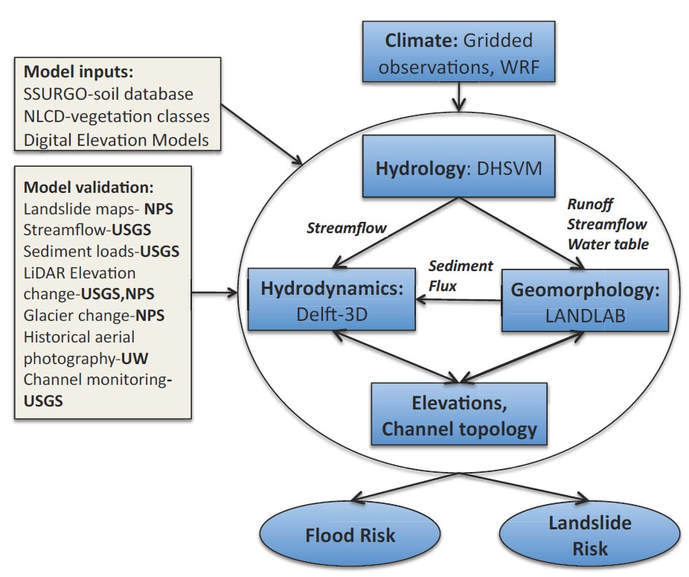Geomorphology
We study geomorphology from time-scales of mountain evolution to flood response
|
High-traffic, near-stream (HTNS) unpaved forest roads associated with timber production are some of the largest sources of excess, human-caused fine sediment in nearby streams. This fine-grained sediment generated by and transported from HTNS forest roads can adversely affect water quality and aquatic resources in nearby watersheds.
The Road Prescription-Scale Effectiveness Monitoring Project (RPSEMP) aims to study the erosion of unpaved forest roads in western Washington and the best ways to mitigate such erosion. This project is funded by the Cooperative Monitoring, Evaluation, and Research (CMER) Committee within the Washington Department of Natural Resources (WADNR) Adaptive Management Program. |

 Modeling framework for PREEVENTs research
Modeling framework for PREEVENTs research
|
Using a geomorphic approach (landscape topographic dynamics), we are developing new ways to predict probabilistic landslide hazard at regional scales using Landlab. The model applications are reproducible on HydroShare (instructions in the link). Our Monte Carlo approach connect uncertainties of the effects of vegetation, soils, and climatology on hillslope stability based on both the infinte slope stability model and empirical data. The products of these models include probabilistic landslide hazard maps that explicitly address uncertainty in site specific information. These maps and our approach can facilitate quantifiable risk assessments that can inform design and decision making in engineering, planning, emergency preparation, and resource management. We demonstrate our approach in the North Cascade mountains of Washington, where steep terrain, active tectonics, glacier dynamics, and high precipitation contribute to relatively frequent landslides. This research was funded by NSF, CBET-1336725. Probability of landslide initiation is illustrated with a figure on the left from Strauch et al. (2018): (a) high-resolution (0.3 m) imagery of a NOCA mountain compared to (b) P(F) simulated by modeled soil depth with mapped debris avalanches. Imagery from World Imagery, Esri Inc., created using ArcGIS® software by Esri.
|